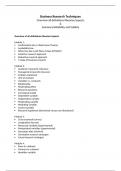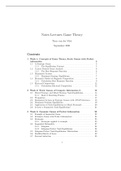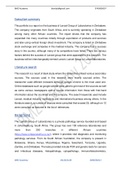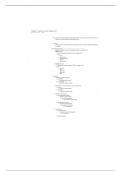Applied Data Analysis
Assignment 1
Excercise 1
A)
Figure 1. Histogram Male Honour
Figure 2. Histogram Ethnic Group
, B) The sample consists of 139 participants. When looking at ethnicity, there are 68 Dutch
participants (48.9%) and 71 Hindu participants (51.1%). The statistics of Male Honour can be
found in Table 1.
Table 1. Descriptives Statistics of Male Honour
N statistic Minimum Maximum Mean Std. Deviation
Male 139 6 22 17.72 3.12
Honour
C)
Table 2. Normality test of Male Honour
Standardized Standardized Kolmogorov Kolmogoro Kolmogorov
Skewness Kurtosis -Smirnov v -Smirnov
Statistic -Smirnov Sig.
df
Male -4.98* 2.50* .16 139 <.001
Honour
*p < 0.05
We computed the skewness and kurtosis for the male honour variable. We computed the
significance of skewness and kurtosis by comparing the resulting z-scores to the expected
values that you would get if skewness and kurtosis did not differ from 0. Thus, when an
absolute value is greater than 1.96 or smaller than -1.96, it is significant at p < 0.05. This was
true for both skewness and kurtosis.
In Table 2 it is shown that the male honour variable contains a large negative number, which
indicates for a pile-up on the right. This denotes negatives skewness. The kurtosis value for
male honour is a significant, positive value. This shows that the actual peak is higher than you
would expect.
We performed a Kolmogorov-Smirnov test to see whether the distribution actually
significantly differ from normality. The score for male honour, D(139) = .16, p < .001 showed
significance.
D)
The scores of skewness and kurtosis indicate that the data is not normally distributed, due to
the significance of the skewness and kurtosis values.
Besides that, the score for the Kolmogorov-Smirnov test was significant for male honour,
which suggests that the variable male honour doesn’t have a normal distribution.
Both these findings denote that the distribution of the variable male honour is not normally
distributed.
E)
We created two boxplots with the variables male honour and ethnicity. We did this in order to
see whether there are differences between the two subgroups of ethnicity, the Dutch and the
Hindu group. Figure 3 shows us that the median of the Dutch group is lower than the Hindu
group, this indicates that the Dutch rated male honour lower and the Hindu rated male honour
higher. Besides that, the middle 50% of the Dutch group is bigger than the Hindu group,
which shows that there is more variety in male honour in the Dutch group than there is in the
Hindu group. In addition, the boxplots show that the highest 25% of the Dutch show less male
Assignment 1
Excercise 1
A)
Figure 1. Histogram Male Honour
Figure 2. Histogram Ethnic Group
, B) The sample consists of 139 participants. When looking at ethnicity, there are 68 Dutch
participants (48.9%) and 71 Hindu participants (51.1%). The statistics of Male Honour can be
found in Table 1.
Table 1. Descriptives Statistics of Male Honour
N statistic Minimum Maximum Mean Std. Deviation
Male 139 6 22 17.72 3.12
Honour
C)
Table 2. Normality test of Male Honour
Standardized Standardized Kolmogorov Kolmogoro Kolmogorov
Skewness Kurtosis -Smirnov v -Smirnov
Statistic -Smirnov Sig.
df
Male -4.98* 2.50* .16 139 <.001
Honour
*p < 0.05
We computed the skewness and kurtosis for the male honour variable. We computed the
significance of skewness and kurtosis by comparing the resulting z-scores to the expected
values that you would get if skewness and kurtosis did not differ from 0. Thus, when an
absolute value is greater than 1.96 or smaller than -1.96, it is significant at p < 0.05. This was
true for both skewness and kurtosis.
In Table 2 it is shown that the male honour variable contains a large negative number, which
indicates for a pile-up on the right. This denotes negatives skewness. The kurtosis value for
male honour is a significant, positive value. This shows that the actual peak is higher than you
would expect.
We performed a Kolmogorov-Smirnov test to see whether the distribution actually
significantly differ from normality. The score for male honour, D(139) = .16, p < .001 showed
significance.
D)
The scores of skewness and kurtosis indicate that the data is not normally distributed, due to
the significance of the skewness and kurtosis values.
Besides that, the score for the Kolmogorov-Smirnov test was significant for male honour,
which suggests that the variable male honour doesn’t have a normal distribution.
Both these findings denote that the distribution of the variable male honour is not normally
distributed.
E)
We created two boxplots with the variables male honour and ethnicity. We did this in order to
see whether there are differences between the two subgroups of ethnicity, the Dutch and the
Hindu group. Figure 3 shows us that the median of the Dutch group is lower than the Hindu
group, this indicates that the Dutch rated male honour lower and the Hindu rated male honour
higher. Besides that, the middle 50% of the Dutch group is bigger than the Hindu group,
which shows that there is more variety in male honour in the Dutch group than there is in the
Hindu group. In addition, the boxplots show that the highest 25% of the Dutch show less male










